
A power kite or traction kite is a large kite designed to provide significant pull to the user.

A power kite or traction kite is a large kite designed to provide significant pull to the user.
The two most common forms are the foil, and the leading edge inflatable. There are also other less common types of power kite including rigid-framed kites and soft single skin kites. There are several different control systems used with these kites which have two to five lines and a bar or handles.
Foil kites consist of a number of cells with cloth ribs in each cell. It is the profile of these ribs that gives the kite its aerofoil shape and enable it to generate lift. The most common type is the ram-air foil, where each cell has a gauze-covered opening at the front, meaning air is forced in during flight, giving the kite its stiffness and enabling it to hold its profile. Some ram-air foils are closed-cell, where a one-way valve locks the air inside the cells, giving some increased water relaunch capability.
Leading edge inflatable kites (LEIs) are made of a single skin of fabric with, as the name suggests, an inflated tubular leading edge and inflated ribs. The leading edge and ribs are inflated by the user with a pump prior to launching the kite. The profile of an LEI type kite comes from the inflatable edge and ribs. LEI kites are primarily used for kitesurfing, as they retain their structure when wet and can be easily relaunched from the water after sitting on the surface for an extended period. Conversely, an open-celled foil kite crashed into the sea immediately becomes saturated with water and unflyable.
Power kites are generally used in conjunction with a vehicle or board, such as in:
Power kites can also be used recreationally without a vehicle or board, as in kite jumping or kite man lifting, where a harnessed kite flier is moored to the ground or one or more people to provide tension and lift
Research is also under way in the use of kites to generate electric power to be fed into a power grid. [1] [2] [3] [4] Laddermills [5] are a type of airborne wind turbine. Kites are used to reach high altitude winds such as a jet stream, which are always present, even if ground level winds available to wind turbines are absent.
Kites of related design are used for sailing, including speed sailing. Jacob's Ladder, a kite-powered boat, set the C-Class world sailing speed record with a speed of 25 knots (46 km/h) in 1982, a record that stood for six years. [6] A kiteboard was the first sailing craft to exceed a speed of 50 knots (93 km/h) in October 2008. [6]
Power kites range in size from 1.2 to 50 m2 (13 to 538 sq ft). All kites are made for specific purposes: some for water, land, power or maneuverability.
The lift generated by the kite and other flying characteristics are affected by the kite's angle of attack, which is set by the bridle; the arrangement of lines which terminate the main kite lines and attach to a number of points across the kite's surface. Power kites having 4 or 5 lines come in two variants, fixed bridle and depowerable.
Fixed bridle kites have a fixed angle of attack which is set by the bridle. Small adjustments may be possible by adjusting the bridle with the kite on the ground, however the angle of attack is not adjustable whilst the kite is airborne. A high angle of attack setting results in more power from the kite, but at the expense of speed and ability to fly close to the wind. A low angle of attack results in less power, but speed is increased and the kite can fly a lot closer to the edge of the wind window. [7] Fixed bridle kites may be used with handles or a bar, with handles typically being preferable for activities such as kite jumping and kite buggying, and a bar being preferable for kite landboarding.
Depowerable kites are used with a control bar and harness system, with the kite's primary power lines attached to the user's harness through a hole in the centre of the bar. The bar has a few inches of travel along the lines, and the lines are configured such that the user may pull the bar towards themselves to increase the kite's angle of attack, increasing the lift and thus the power delivered through the harness whilst the kite is in flight. Kites used for kitesurfing are almost invariably depowerable, and some modern kites such as bow kites allow power to be reduced by almost 100% for increased safety and versatility.
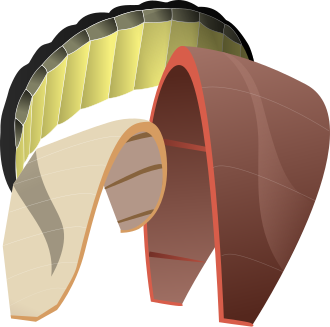
Kite safety systems have become more prevalent in recent years, and today almost all 4 and 5 line kites are used with a safety system designed to remove power from the kite in the event that the user becomes overpowered or loses control of the kite. When flying a fixed bridle kite, one or more straps known as 'kite killers' are attached to the user's wrist(s) by bungee cords. When the handles or bar are released, these straps pull on the kite's brake lines at the trailing edge of the kite, allowing the kite to flap in the wind with no structure.
Depowerable kites have safety systems that work in a similar way, but since the kite is semi-permanently attached to the user's harness, a toggle or handle is used to activate the safety system which releases the bar and power lines from the harness.
Some depowerable kites have a 5th line safety system, the 5th line being redundant during normal use until the safety mechanism is activated. Here, all of the usual four lines are slackened, causing the kite to either fold or roll backwards, and lose its profile to the wind and therefore its power. The kite is left attached to the user by the 5th line to allow retrieval.
In the 1800s, George Pocock used kites of increased size to propel carts on land and ships on the water, using a four-line control system—the same system in common use today. Both carts and boats were able to turn and sail upwind. The kites could be flown for sustained periods. [8] The intention was to establish kitepower as an alternative to horsepower, partly to avoid the hated "horse tax" that was levied at that time. [9] Aviation pioneer Samuel Cody developed several "man-lifting kites" and in 1903 succeeded in crossing the English Channel in a small collapsible canvas boat powered by a kite. [10]
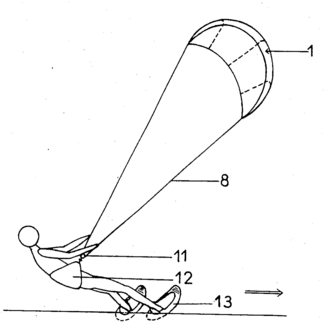

In the late 1970s, the development of Kevlar then Spectra flying lines and more controllable kites with improved efficiency contributed to practical kite traction. In 1978, Ian Day's "FlexiFoil" kite-powered Tornado catamaran exceeded 40 km/h.
In October 1977 Gijsbertus Adrianus Panhuise (Netherlands) received the first patent [12] for KiteSurfing. The patent covers, specifically, a water sport using a floating board of a surf board type where a pilot standing up on it is pulled by a wind catching device of a parachute type tied to his harness on a trapeze type belt. Although this patent did not result in any commercial interest, Gijsbertus Adrianus Panhuise could be considered as the originator of KiteSurfing.
On 28 August 1982 Greg Locke and Simon Carter, from Brighton UK, set the world record for kite traction at sea, travelling nearly 26 miles under wind power alone along the English channel. [13] This followed a successful crossing of the English Channel from Sussex to France by Locke & Carter the previous year.
Through the 1980s, there were occasionally successful attempts to combine kites with canoes, ice skates, snow skis, [14] water skis and roller skates.
Throughout the 1970s and early 1980s, Dieter Strasilla from Germany developed parachute-skiing and later perfected a kite-skiing system using self-made paragliders and a ball-socket swivel allowing the pilot to sail upwind and uphill but also to take off into the air at will. [15] Strasilla and his Swiss friend Andrea Kuhn used this invention also in combination with surfboards and snowboards, grasskies and self-made buggies. [16] One of his patents describes in 1979 the first use of an inflatable kite design for kitesurfing. [17]
Two brothers, Bruno Legaignoux and Dominique Legaignoux, from the Atlantic coast of France, developed kites for kitesurfing in the late 1970s and early 1980s and patented an inflatable kite design in November 1984, a design that has been used by companies to develop their own products.
In 1990, practical kite buggying was pioneered by Peter Lynn at Argyle Park in Ashburton, New Zealand. Lynn coupled a three-wheeled buggy with a forerunner of the modern parafoil kite. Kite buggying proved to be popular worldwide, with over 14,000 buggies sold up to 1999.
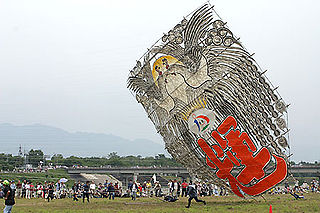
A kite is a tethered heavier-than-air or lighter-than-air craft with wing surfaces that react against the air to create lift and drag forces. A kite consists of wings, tethers and anchors. Kites often have a bridle and tail to guide the face of the kite so the wind can lift it. Some kite designs don’t need a bridle; box kites can have a single attachment point. A kite may have fixed or moving anchors that can balance the kite. One technical definition is that a kite is “a collection of tether-coupled wing sets“. The name derives from its resemblance to a hovering bird.

Kiteboarding or kitesurfing is an extreme sport where the kiter uses the wind power with a large power kite to be pulled on a water, land or snow surface. It combines aspects of paragliding, surfing, windsurfing, skateboarding, snowboarding and wakeboarding. Kiteboarding is among the less expensive and the more convenient of the sailing sports.

The Rogallo wing is a flexible type of wing. In 1948, Francis Rogallo, a NASA engineer, and his wife Gertrude Rogallo, invented a self-inflating flexible wing they called the Parawing, also known after them as the "Rogallo Wing" and flexible wing. NASA considered Rogallo's flexible wing as an alternative recovery system for the Mercury and Gemini space capsules, and for possible use in other spacecraft landings, but the idea was dropped from Gemini in 1964 in favor of conventional parachutes.

Foil kites are soft kites based on the design of the parafoil. They consist of a number of cells running fore to aft, some or all of which are open at the front to allow air to inflate the kite so it takes on an aerofoil section. Due to the amount of power that these kites can generate, they can be used for a variety of different activities including kitesurfing, kite landboarding, snowkiting, kite buggying, kite-energy systems or airborne wind energy, and recreational kiting.
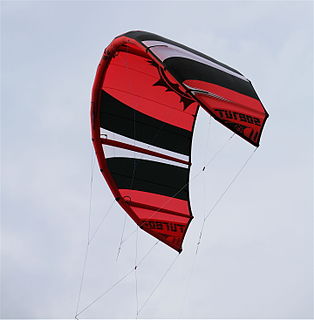
A leading edge inflatable kite (LEI) is a single skin kite with inflatable bladders providing structure. It is useful as a power or traction kite. These kites are flown using 2, 4 or 5 control lines and a bar. A LEI is a great kite for water use because the inflated bladders cause it to float on the water surface. A LEI can sit on the water for an indefinite time and still be relaunched because, unlike a foil kite, there are no chambers that can fill with water. Generally used for kitesurfing and kiteboarding, leading edge inflatable kites come in many different sizes, most commonly from 5 to 18 square metres.
Kite types, kite mooring, and kite applications result in a wide variety of kite control systems. Contemporary manufacturers, kite athletes, kite pilots, scientists, and engineers are expanding the possibilities.

A foilboard or hydrofoil board is a surfboard with a hydrofoil that extends below the board into the water. This design causes the board to leave the surface of the water at various speeds.
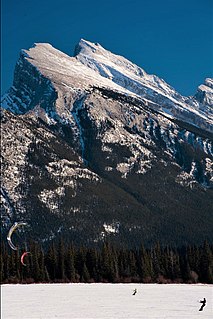
Snowkiting or kite skiing is an outdoor winter sport where people use kite power to glide on snow or ice. The skier uses a kite to give them power over large jumps. The sport is similar to water-based kiteboarding, but with the footwear used in snowboarding or skiing. The principles of using the kite are the same, but in different terrain. In the early days of snowkiting, foil kites were the most common type; nowadays many kiteboarders use inflatable kites. However, since 2013, newly developed racing foil kites seem to dominate speed races and expedition races, like Red Bull Ragnarok and the Vake mini-expedition race. Snowkiting differs from other alpine sports in that it is possible for the snowkiter to travel uphill and downhill with any wind direction. Like kiteboarding, snowkiting can be very hazardous and should be learned and practiced with care. Snowkiting is becoming increasingly popular in places often associated with skiing and snowboarding, such as Russia, Canada, Iceland, France, Switzerland, Austria, Norway, Sweden, Finland and the Northern and Central United States. The sport is becoming more diverse as adventurers use kites to travel great distances and sports enthusiasts push the boundaries of freestyle, big air, speed and back country exploration.
A kite buggy is a light, purpose-built vehicle powered by a traction kite. It is single-seated and has one steerable front wheel and two fixed rear wheels. The driver sits in the seat located in the middle of the vehicle and accelerates and slows down by applying steering manoeuvres in coordination with flying manoeuvres of the kite. This activity is called kite buggying. The speed achieved in kite buggies by skilled drivers can range up to around 110 km/h (70 mph), hence protective clothing, including a safety helmet, is commonly worn.

Kite landboarding, also known as land kiteboarding or flyboarding, is based on the sport of kitesurfing, where a rider on a surf-style board is pulled over water by a kite. Kite landboarding involves the use of a mountain board or landboard, which is essentially an oversized skateboard with large pneumatic wheels and foot-straps. Kite landboarding is a growing sport, and there are several competitions. Kite landboarding is attracting growing publicity although it is not yet as popular or as well known as kitesurfing.

Peter Lynn is a New Zealand kitemaker, engineer and inventor. He is notable for his construction of the world's largest kites, giant inflatable (sparless) display kites, the popularisation of kite buggying and contributions to the development of power kiting and kitesurfing. He spends much of the year travelling worldwide and displaying his kites at International Kite Festivals.
Airborne wind energy (AWE) is the direct use or generation of wind energy by the use of aerodynamic or aerostatic lift devices. AWE technology is able to harvest high altitude winds, in contrast to wind turbines, which use a rotor mounted on a tower.

Bow kites are leading edge inflatable kites that incorporate a bridle on the leading edge. They are used for the sport of kiteboarding. They can be identified by a flat, swept-back profile and concave trailing edge allowing the kite greater depower. Bow kite design was pioneered by Bruno Legaignoux, and have been licensed to many kite manufacturers. The first major manufacturer to introduce these bow kites to the United States was Cabrinha Kites.

Kites are tethered flying objects which fly by using aerodynamic lift, requiring wind for generation of airflow over the lifting surfaces.

The paravane is a towed winged (hydrofoiled) underwater object—a water kite. Paravanes have been used in sport or commercial fishing, marine exploration and industry, sports and military. The wings of paravanes are sometimes in a fixed position, else positioned remotely or by actions of a human pilot. Pioneer parafoil developer Domina Jalbert considered water kites hardly different from air kites. However, paravanes generally orient themselves in respect to the water surface. They may have sensors that record or transmit data or be used entirely for generating a holding force like a sea anchor does. While a sea-anchor allows a vessel to drift more slowly downwind, the paravane travels sideways at several times the downwind speed. Paravanes are, like air kites, often symmetrical in one axis and travel in two directions, the change being effected by gybing, shunting, or flipping over.
Supported leading edge kite (SLE) is a type of power kite used mainly for kitesurfing.
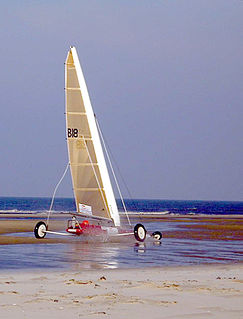
Wind-powered vehicles derive their power from sails, kites or rotors and ride on wheels—which may be linked to a wind-powered rotor—or runners. Whether powered by sail, kite or rotor, these vehicles share a common trait: As the vehicle increases in speed, the advancing airfoil encounters an increasing apparent wind at an angle of attack that is increasingly smaller. At the same time, such vehicles are subject to relatively low forward resistance, compared with traditional sailing craft. As a result, such vehicles are often capable of speeds exceeding that of the wind.
The arckite or twinskin kite is a type of traction kite designed and patented by Peter Lynn. It is a very stable, safe and secure type of powerkite. It can be used for all kinds of kite powered sports, for example: kiteboarding, landboarding, kite buggying or snowkiting. The shape of the kite is similar to a C shaped leading edge inflatable kite, however the construction is similar to a foil kite. These kites also fall into a category of foils called "closed-cell inflatables", meaning that the ram-air inlets on the leading edge of the kite are normally closed by flaps that act as one-way valves to maintain internal air pressure. It is this feature that makes the kite useful for kitesurfing since, unlike standard open-cell foils, if the kite crashes on the water, it will stay inflated and float long enough for the rider to recover and re-launch.
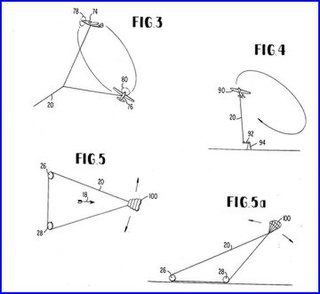
Crosswind kite power is power derived from a class of airborne wind-energy conversion systems or crosswind kite power systems (CWKPS) characterized by a kite system that has energy-harvesting parts that fly transverse to the direction of the ambient wind, i.e., to crosswind mode; sometimes the entire wing set and tether set is flown in crosswind mode. These systems at many scales from toy to power-grid-feeding sizes may be used as high-altitude wind power (HAWP) devices or low-altitude wind power (LAWP) devices without having to use towers. Flexible wings or rigid wings may be used in the kite system. A tethered wing, flying in crosswind at many times wind speed, harvests wind power from an area that is many times exceeding the wing's own area. Crosswind kite power systems have some advantages over conventional wind turbines: access to more powerful and stable wind resource, high capacity factor, capability for deployment on and offshore at comparable costs, and no need for a tower. Additionally, the wings of the CWKPS may vary in aerodynamic efficiency; the movement of crosswinding tethered wings is sometimes compared with the outer parts of conventional wind turbine blades. However, a conventional traverse-to-wind rotating blade set carried aloft in a kite-power system has the blade set cutting to crosswind and is a form of crosswind kite power. Miles L. Loyd furthered studies on crosswind kite power systems in his work "Crosswind Kite Power" in 1980. Some believe that crosswind kite power was introduced by P. Payne and C. McCutchen in their patent No. 3,987,987, filed in 1975, however, crosswind kite power was used far before such patent, e.g., in target kites for war-target practice where the crosswinding power permitted high speeds to give practice to gunners.
Kite rigs are wind-assisted propulsion systems for propelling a vehicle. They differ from conventional sails in that they are flown from kite control lines, not supported by masts.